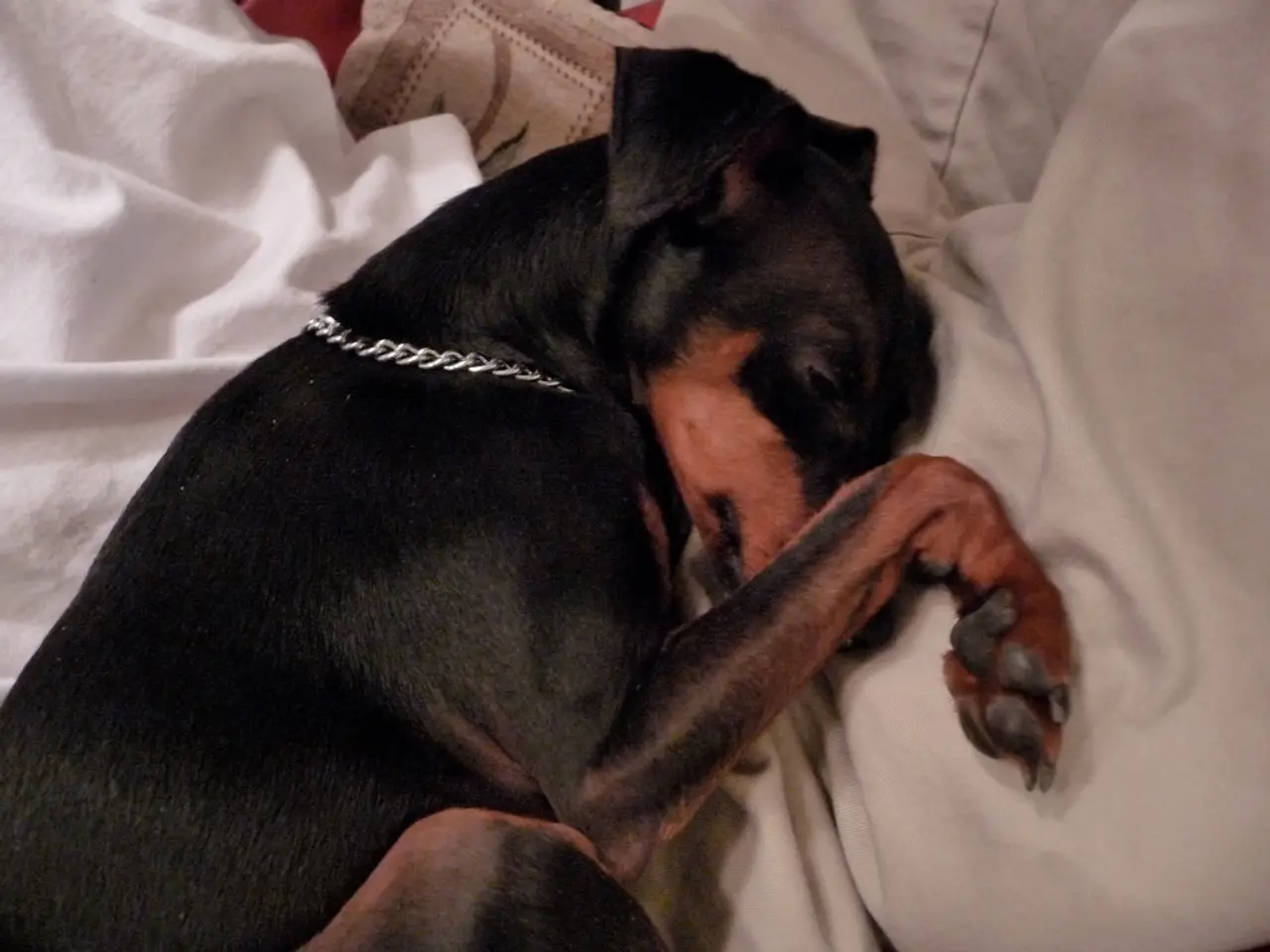Symptoms to Look for in Canine Dementia
In the world of our beloved canine companions, a condition known as canine cognitive dysfunction (CCD) or dog dementia can pose a significant challenge. This ailment, much like its human counterpart, manifests in various ways, including disorientation or confusion in familiar environments, increased anxiety, changes in sleep patterns, house soiling, altered interactions, pacing or circling, memory loss, restlessness, and increased snappiness or agitation [1][2][3]. These symptoms, collectively remembered by the DISHAA acronym, are signs that your dog may be experiencing cognitive decline [1].
Fortunately, there are several steps pet owners can take to manage canine dementia and improve their dog's quality of life.
- Provide reassurance and help your dog feel safe when confused or anxious [1]. This can be achieved through gentle words, soothing touch, and a comforting presence.
- Maintain a consistent routine to reduce stress and confusion [3]. Dogs thrive on routine, and by sticking to familiar patterns, you can help alleviate some of the anxiety associated with dementia.
- Engage dogs in mental and physical enrichment exercises to stimulate their brain [2]. This could include puzzle toys, gentle training sessions, or interactive games that challenge your dog's cognitive abilities.
- Adjust diet by incorporating high-quality food and brain-supportive supplements such as antioxidants, omega-3 fatty acids (DHA), vitamins C and E, SAMe, and amino acids to potentially slow cognitive decline [2][5]. Consult with your veterinarian about the best dietary plan for your dog.
- Consult a veterinarian who may prescribe medications like selegiline that can improve brain function in some dogs [5]. Selegiline, a psychopharmaceutical, can help support cognitive function in dogs with dementia.
- Modify the home environment to make navigation easier—e.g., keep familiar pathways clear, use night lights, and ensure easy access to favorite spots or the outdoors [5].
- Monitor behavior changes and maintain regular veterinary check-ups to rule out other health issues and adjust care plans accordingly [3][5].
In addition to these steps, there are other measures that can help manage the symptoms of dementia, provide comfort, and maintain your dog’s quality of life as much as possible [5]. For instance, calming pheromones can help soothe dogs experiencing anxiety or confusion, and can help calm a dog with dementia at night. Ensuring easy, unobstructed access to favorite resting spots is important, as is creating a calm environment that enables dogs with dementia to rest as much as possible.
Dogs with dementia may become more sensitive and reactive to sights and sounds, and develop a heightened fear of unfamiliar environments. They may also show increased anxiety, becoming more clingy or needy, and glued to their pet parents. Dogs with dementia often experience changes in learning and memory, struggling to learn new tasks and forgetting commands or routines they once knew well.
Supplements like Senilife and specially formulated dog foods that incorporate brain-supporting ingredients can be helpful tools for managing dog dementia. Making thoughtful adjustments at home to better support a dog with dementia is the most important step pet parents can take. Keeping doors open or closing off certain areas of the home can prevent confusion for dogs with dementia.
In conclusion, managing canine dementia requires a multi-faceted approach that considers the physical, emotional, and cognitive needs of your dog. By understanding the signs of canine dementia and implementing the strategies outlined above, you can help your dog live a happier, healthier life despite this challenging condition.
Sources:
- Expert Insights on DISHAA (Dementia signs)
- [1] PetsRadar signs of dementia in dogs, Dr. Charlotte Rice
- [2] BetterPet guide on brain health and supplements
- [3] Wamiz: Alzheimer's and canine cognitive dysfunction signs
- [5] TheTrainingOfDogs.com: Dementia management and veterinary care
- [6] Senilife, a popular supplement for managing canine dementia.
- [7] Specially formulated dog foods that incorporate brain-supporting ingredients can be helpful tools for managing dog dementia.
- The multi-faceted approach to managing canine dementia includes providing mental stimulation through fitness-and-exercise and enrichment exercises to help stimulate the dog's brain.
- For dogs with dementia, ensuring a healthy nutrition is important, with high-quality food and brain-supportive supplements like antioxidants, omega-3 fatty acids (DHA), vitamins C and E, SAMe, and amino acids potentially slowing cognitive decline.
- To create a comfortable environment for dogs with dementia, pet owners can incorporate health-and-wellness measures such as calming pheromones, easy access to favorite resting spots, and a calm home environment to aid in their dog's rest.




